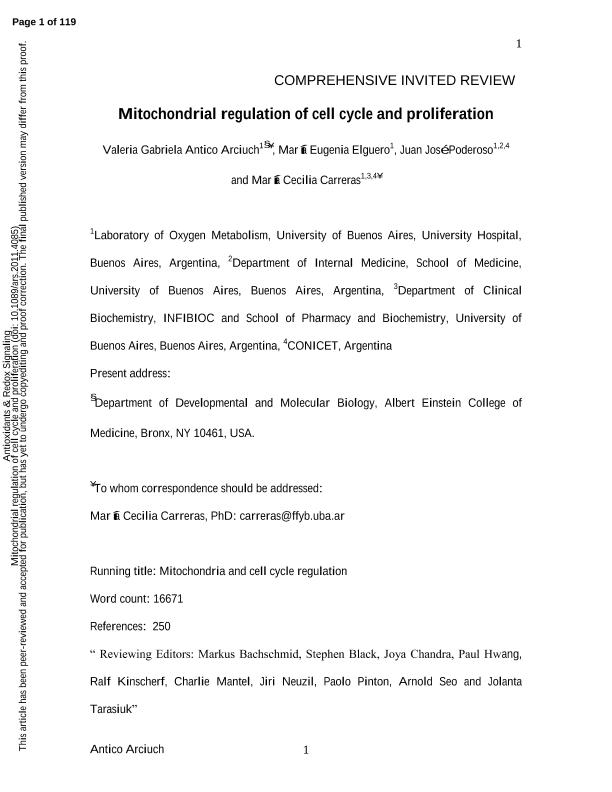Artículo
Mitochondrial regulation of cell cycle and proliferation
Antico Arciuch, Valeria Gabriela ; Elguero, María Eugenia
; Elguero, María Eugenia ; Poderoso, Juan José
; Poderoso, Juan José ; Carreras, Maria Cecilia
; Carreras, Maria Cecilia
 ; Elguero, María Eugenia
; Elguero, María Eugenia ; Poderoso, Juan José
; Poderoso, Juan José ; Carreras, Maria Cecilia
; Carreras, Maria Cecilia
Fecha de publicación:
05/2012
Editorial:
Mary Ann Liebert
Revista:
Antioxidants & Redox Signaling
ISSN:
1523-0864
Idioma:
Inglés
Tipo de recurso:
Artículo publicado
Clasificación temática:
Resumen
Eukaryotic mitochondria resulted from symbiotic incorporation of α-proteobacteria into ancient archaea species. During evolution, mitochondria lost most of the prokaryotic bacterial genes and only conserved a small fraction including those encoding 13 proteins of the respiratory chain. In this process, many functions were transferred to the host cells, but mitochondria gained a central role in the regulation of cell proliferation and apoptosis, and in the modulation of metabolism; accordingly, defective organelles contribute to cell transformation and cancer, diabetes, and neurodegenerative diseases. Most cell and transcriptional effects of mitochondria depend on the modulation of respiratory rate and on the production of hydrogen peroxide released into the cytosol. The mitochondrial oxidative rate has to remain depressed for cell proliferation; even in the presence of O 2, energy is preferentially obtained from increased glycolysis (Warburg effect). In response to stress signals, traffic of pro-and antiapoptotic mitochondrial proteins in the intermembrane space (B-cell lymphoma-extra large, Bcl-2-associated death promoter, Bcl-2 associated X-protein and cytochrome c) is modulated by the redox condition determined by mitochondrial O 2 utilization and mitochondrial nitric oxide metabolism. In this article, we highlight the traffic of the different canonical signaling pathways to mitochondria and the contributions of organelles to redox regulation of kinases. Finally, we analyze the dynamics of the mitochondrial population in cell cycle and apoptosis. Antioxid. Redox Signal.
Palabras clave:
Symbiotic
,
Metabolism
,
Glycolysis
,
Apoptosis
Archivos asociados
Licencia
Identificadores
Colecciones
Articulos(INIGEM)
Articulos de INSTITUTO DE INMUNOLOGIA, GENETICA Y METABOLISMO
Articulos de INSTITUTO DE INMUNOLOGIA, GENETICA Y METABOLISMO
Citación
Antico Arciuch, Valeria Gabriela; Elguero, María Eugenia; Poderoso, Juan José; Carreras, Maria Cecilia; Mitochondrial regulation of cell cycle and proliferation; Mary Ann Liebert; Antioxidants & Redox Signaling; 16; 10; 5-2012; 1150-1180
Compartir
Altmétricas



